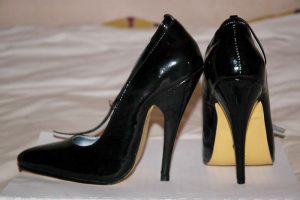 It’s mid-summer — so naturally it is time for another article on high heels in the workplace.
It’s mid-summer — so naturally it is time for another article on high heels in the workplace.
She Refused To Wear High Heels! We Need A Review!
In early 2017, it was reported that members of the UK Parliament “have called for a review of the 2010 Equality Act after receiving hundreds of reports of dresscode discrimination. Women told two Commons’ committees how employers demanded they wear revealing clothes, dye their hair blonde and constantly reapply their make-up while at work.”

Transform Legal Reasoning Into Business-Ready Results With General AI
Protégé™ General AI is fundamentally changing how legal professionals use AI in their everyday practice.
The Parliamentary inquiry was a result of a petition started by a woman “who was sent home by her employer, PricewaterhouseCoopers (PwC) in London, on her first day with them because she refused to wear heels. Her petition to make this dresscode policy illegal reached more than 150,000 signatures.”
The woman declared that “[t]his wasn’t just about shoes. It was about the treatment of women in the workplace. We now need to see the government take these recommendations on board. The law should not just be changed but enforced.”
I wrote about this here a year ago and asked, “[A]re workplace codes governing women’s dress simply business regimentation – or the policing/fetishizing/sexualizing of women?”
And then I delved into a lengthy discussion of the history of high heels (for males and females) as status symbols, “signifiers of power,” as sexualizing women for the “scrutiny” of men, and noted that sociologist Zuleyka Zevallos said that “heels become a symbol of femininity for the same reason they were once loved by wealthy European men: they are painful, impractical and frivolous.”

4 Ways Your Firm Can Build Economic Resilience
It’s the key to long-term success in an uncertain business climate.
I concluded by quoting a piece in BuzzFeed: “Puritans in Colonial Massachusetts went so far as to ban high heels, believing that they were lewd. For Shakespeare, women’s feet were vaginal symbols … for Sigmund Freud [not a paragon of feminism], ‘high heels were a vessel to a woman’s genitals.’” Oy vey.
Parliament’s New Dress Code Guidance
Well, it turns out that the ordered Parliamentary inquiry has, at long last, yielded results.
The UK’s Government Equalities Office drafted and published a guidance on workplace dress code compliance with the 2010 Equality Act. The Guidance is basically advice for employers, and claims to “set[] out how the law might apply in cases of sex discrimination where an employer requires female staff to wear, for instance, high heels, make-up, hair of a particular length or style, or revealing clothing.”
It states that “[i]t is advisable to avoid gender specific prescriptive requirements. For example, any requirement to wear make-up, have manicured nails, wear hair in certain styles or to wear specific types of hosiery or skirts is likely to be unlawful, assuming there is no equivalent requirement for men.”
Required High Heels And Makeup For Women: OK If “Equivalent Standard” for Men
Addressing the high heels issue — which prompted the whole endeavor — it gave as an example: “An employer requires female staff to wear high heels as part of a dress code but places no footwear requirements on men or merely requires them to look smart. This is likely to constitute direct discrimination on grounds of sex because there is not an equivalent standard imposed on male staff.”
Sounds fair — employers can require that women wear high heels as long as men are required to wear high heels.
But wait a sec — the Guidance doesn’t quite say that.
It says that it is OK to require that women wear high heels as long as there is an “equivalent standard” for men. The Guardian writer picked up on this when she said that men are never expected to wear high heels so an “equivalent standard” for men might be simply “smart shoes.”
She claimed that “[t]he guidance is bland and vague. … The government could and should have made it explicitly clear that a requirement or expectation that women wear heels, makeup, and skirts to work will virtually always amount to unlawful sex discrimination, period, and it does not matter what standards are set for men in the workplace.”
Point taken.
The Guardian writer said that “[w]e are still stuck with sexist dress codes,” and caustically added that “Perhaps we should not be too surprised … the last time there was any parliamentary consideration of dress codes and equality was in 2011, when a certain Mrs. May, then minister for women and equalities, responded to a written question that she believed ‘traditional gender-based workplace dress codes … encourage a sense of professionalism in the workplace.’”
Another point taken.
Takeaway
None today.
Footnote: Wear A “Nice Low Neckline”
It was reported that the Brussels Free University (Université libre de Bruxelles) sent an email that at the upcoming graduation ceremony “from an aesthetic point of view, it is preferable if young women wear a dress or a skirt and a nice low neckline.”
It said that male graduates could wear a suit.
The University later apologized on Facebook – but not before there were 600 comments such as “Is this a joke? They are graduates of medicine and we’re asking them to show their chest?” and “The dress I can understand but the ‘nice cleavage’ you got a Phd, but who cares, shows your nipples.”
Progress. Is. Slow.
 Richard B. Cohen has litigated and arbitrated complex business and employment disputes for almost 40 years, and is a partner in the NYC office of the national “cloud” law firm FisherBroyles. He is the creator and author of his firm’s Employment Discrimination blog, and received an award from the American Bar Association for his blog posts. You can reach him at [email protected] and follow him on Twitter at @richard09535496.
Richard B. Cohen has litigated and arbitrated complex business and employment disputes for almost 40 years, and is a partner in the NYC office of the national “cloud” law firm FisherBroyles. He is the creator and author of his firm’s Employment Discrimination blog, and received an award from the American Bar Association for his blog posts. You can reach him at [email protected] and follow him on Twitter at @richard09535496.